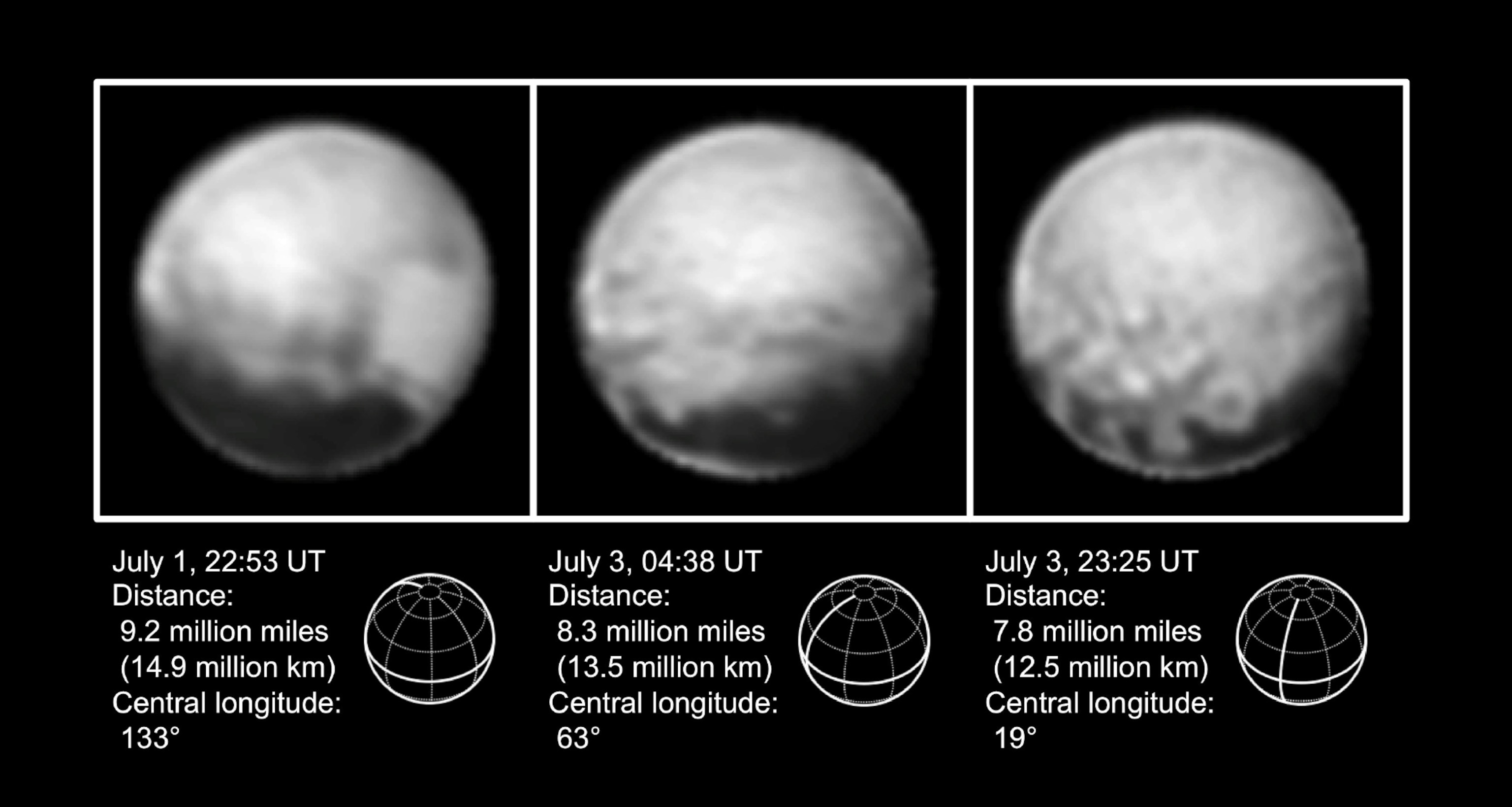
Pluto Spacecraft Sends Photos As Excitement Builds for Flyby
After the New Horizons spacecraft briefly went silent, NASA quickly returned it to full operations and has released bizarre new photos of Pluto.
Pluto will get its closeup in less than a week, despite a heart-stopping glitch that briefly silenced the New Horizons spacecraft over the holiday weekend. Now, the craft is back in action and entering what NASA calls encounter mode—where gathering data about the frosted world trumps just about everything else.
At 12:34 p.m. Eastern time on Tuesday, New Horizons’ computers will initiate thousands of autonomous command sequences that will direct, the piano-size robot to learn as much as it can about Pluto and its five moons. (Learn more in National Geographic's July cover story on Pluto.)
“The spacecraft is ready now to execute the nine days of flyby operations,” said the mission's principal investigator, Alan Stern of the Southwest Research Institute. “New Horizons is operating flawlessly.”
Though closest approach is still a week away, photos coming back from the $700- million mission are already tantalizing. The latest, released yesterday, show an oddly blotchy terrain punctuated by a dark band around Pluto’s middle.
By July 14, New Horizons will have flown within 8,000 miles of the dwarf planet. At a speed of roughly 30,000 miles per hour, the flyby will be a fleeting encounter, with the craft furiously collecting enough data to keep Earthlings busy for years.
“We came a long way to explore Pluto, and all the early indications are, Pluto’s not gonna let us down,” Stern said. “This object is unlike any other that we have ever observed.”
Speed Bumps, Not Fist Bumps
But this past weekend wasn’t easy for the team.
Around 2 p.m. on July 4, New Horizons lost contact with Earth. At The Johns Hopkins University Applied Physics Laboratory in Laurel, Maryland—home of the mission’s operations center—phones started ringing just as Independence Day revelers would normally be knee-deep in hot dogs.
The first call went to Glen Fountain, the mission’s project manager. He rang Stern, who was in his office on site. Stern then rang Jim Green, NASA’s planetary science director, who was awaiting the imminent birth of his grandson (“What a tremendous weekend,” Green said).
Within minutes, Stern and his colleagues had gathered in mission control. A little more than an hour later, they re-established contact with New Horizons, and quickly figured out the source of the problem: The spacecraft’s’ main onboard computer had attempted two computing-intensive tasks at once. Overloaded, the system switched over the backup computer, which entered what’s called a “safe mode.”

“The spacecraft did exactly what it was supposed to do,” Fountain said. A spacecraft in safe mode ceases collecting data and instead transmits a trickle of a signal to Earth, asking for help from teams on the ground.
“Have you ever tried to recite a list of memorized numbers while someone is reading a different list of numbers aloud to you? You'd probably go into safe mode too,” tweeted New Horizons team member Alex Parker.
Once the craft is in encounter mode, nothing similar is likely to muck up crucial data collecting. If some kind of glitch does occur during flyby, New Horizons will restart itself and continue gathering data instead of shutting down and signaling for help, Fountain says.
Fist Bumps, Not Speed Bumps
In fact, New Horizons’ misadventures in multitasking cost the team very little in terms of mission science. There were only around 30 observations planned during the period it stopped collecting data, a fraction of the nearly 500 observations planned between July 4 and the end of the encounter period, which goes through July 16.
“There was zero impact to the highest priority science,” Stern said.
As the spacecraft continues to close the distance between itself and its mini-planet, teams will be eagerly gathering data on the interplanetary environment, Pluto’s surface features and composition, and the characteristics of those five crazy moons. Already, the images coming back are boggling.
While Pluto’s large moon Charon is gray (with a big dark patch near one pole), Pluto itself is vaguely reddish. The planet’s surface varies wildly in brightness: Some parts are bright, and others very dark. Now, though it’s just 5 million miles from Pluto, New Horizons is still too far away to resolve any of those surface features in detail, but available images reveal a dark band of mystery material wrapped around the planet’s equator. In one area, that band is broken up into four evenly-sized splotches, each about the size of Missouri.
As with most things about Pluto, those spots are still mysterious. But not for long. “I think everyone on the project and in the public is having lots of fun trying to figure out what those markings mean,” says Paul Schenk, a New Horizons team member from the Lunar and Planetary Science Institute.
Follow Nadia Drake on Twitter and on her blog at National Geographic's Phenomena.





